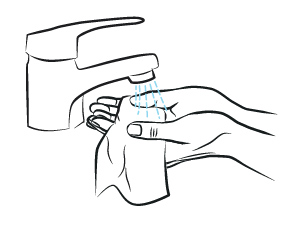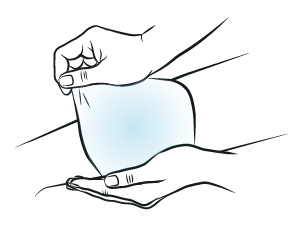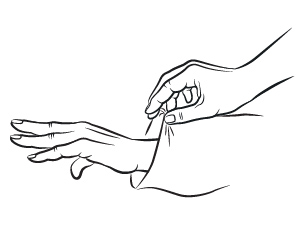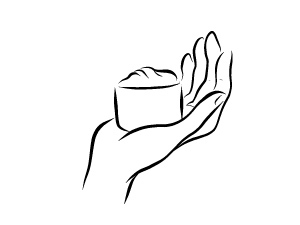Wet Wrap Therapy
For those suffering from an intense eczema flare with severe pain or itch, wet wrap therapy can help.
Basics of wet wrap therapy
When should you use wet wrap therapy?
Wet wrap therapy is a treatment for atopic dermatitis, the most common type of eczema. Doctors typically recommend wet wraps during severe eczema flares when there is severe pain or itch. Wet wrap therapy can help reduce itch and pain and provide some relief.
What is wet wrap therapy?
Wet wrap therapy is when fabric wraps are soaked in water and then applied to the affected skin on the body. This is followed by a secondary dry layer that is left on the skin for a long period of time.
For the best results, wet wrap therapy is typically done after bathing, moisturizing and applying topical medication (such as low to mid potency topical steroids). Doctors call this process of bathing and moisturizing for eczema the soak and seal method. Typically, you do the soak and seal method, followed by wet wraps. Wet wraps are best done in the evening before bed. It is best to leave wet wraps on for several hours or overnight, a loose-fitting layer is put on next, which is often pajamas or a sweatsuit, and it should not disturb the dressing.
For eczema on the feet and/or hands, you can use cotton gloves or socks for the wet layer with vinyl gloves or food-grade plastic wrap as the dry layer. Your healthcare provider can show you how to apply wet wraps on your face.
What are the benefits of wet wrap therapy?
Wet wrap therapy can be very helpful in rehydrating and calming the skin, thanks to the cooling, anti-itch effect. It can also help topical medications work better because the creams or ointments are better able to penetrate the skin.1 One study on using wet wrap therapy on children with severe eczema found that they saw an average 71% reduction in symptoms and maintained healthy skin a month afterwards.2
Can wet wrap therapy be used on all types of eczema?
Wet wrap therapy is considered most effective when someone has moderate to severe atopic dermatitis. In some cases, wet wraps may be recommended for people with dyshidrotic eczema and nummular eczema during severe flares.
Always check with your doctor before starting wet wrap therapy to make sure it’s the right course of treatment for you and suitable for your specific eczema type and severity. It’s also important to create a schedule and treatment plan to avoid over-use of wet wrap therapy.
Downloadable Guide: Soak and Seal and Wet Wraps
Get detailed instructions on how to do the soak and seal method and wet wraps in this downloadable step-by-step guide.
How to do wet wrap therapy at home
How do you apply wet wraps for atopic dermatitis?
Wet wraps are best done in the evening before bed. Follow these step-by-step instructions, starting with a soak and seal to prepare, and then finally the wet wraps to help calm atopic dermatitis symptoms.
Soak and seal step-by-step
What you need:
- Bathtub or sink
- Cleanser
- Topical medications
- Moisturizer
- Water
- Towel
Soak and seal directions:
Step 1: Fill the bathtub with lukewarm water. Soak for 5 to 10 minutes.
Step 2: Use a gentle no-fragrance cleanser. Do not scrub skin.
Step 3: Rinse off with lukewarm water.
Step 4: Pat the skin lightly with a towel. Leave skin slightly damp.
Step 5: Apply prescription topical medication as directed to affected areas of the skin.
Step 6: Within three minutes, liberally apply moisturizer to the rest of your body. Do not apply moisturizer over the areas with topical medication.
Step 7: Wait a few minutes for both to absorb into the skin, then apply wet wraps.
Wet wrap step-by-step
What you need:
- Bathtub or sink
- Water
- Moisturizer
- Clean, cotton clothing for wet dressings
- Pajamas (to go over wet layer)
Wet wrap directions:

Step 1: After you complete the soak and seal method, it’s time to apply wet wraps to affected skin.

Step 2: Moisten the cotton dressing in warm water so it is slightly damp.

Step 3: Wrap the moist dressing around the area affected with atopic dermatitis.

Step 4: Wrap a dry dressing over the wet one.

Step 5: Carefully put pajamas on over these layers so as not to disturb the bandages.

Step 6: Leave dressings on for two hours or overnight.

Step 7: Remove pajamas and wet dressings. Apply moisturizer to areas that were wet wrapped.
Risks of wet wrap therapy
What are the risks of wet wrap therapy for atopic dermatitis?
If you overuse wet wraps for atopic dermatitis, it can lead to obstructed hair follicles called folliculitis. It looks like bumps on the skin. The hair follicles can become inflamed due to too much ointment along with the skin being covered for long periods by the wraps. If this happens, you should stop wet wraps until the bumps clear.
Another risk of wet wraps is potential side effects from topical steroids. Since wet wraps help topical steroids absorb into the skin, you have to be mindful of the amount of topical steroids being used.
Wet wrap therapy for kids with eczema
Dr. Mark Boguniewicz, dermatologist at National Jewish Health in Denver, and an eczema caregiver talk about the benefits of wet wrap therapy for atopic dermatitis.
Related stories
When Should You Use Wet Wraps for Eczema?
Bleach Baths for Atopic Dermatitis — What We Believe, What We Know, What We Don’t Understand
Should You Try Phototherapy for Your Eczema?
References:
1. Lax S, Harvey J, Axon E, Howells L, Santer M, Ridd M, Lawton S, Langan S, Roberts A, Ahmed A, Muller I, Ming L, Panda A, Chernyshov P, Carter B, Williams H, Thomas K, Chalmers J. Strategies for using topical corticosteroids in children and adults with eczema. Cochrane Database of Systemic Reviews. 2022, March 11.
2. Nicol NH, Boguniewicz M, Strand M, Klinnert MD. Wet wrap therapy in children with moderate to severe atopic dermatitis in a multidisciplinary treatment program. J Allergy Clin Immunol Pract. 2014;2(4):400-406. doi:10.1016/j.jaip.2014.04.009
Medically reviewed on March 14, 2025.

